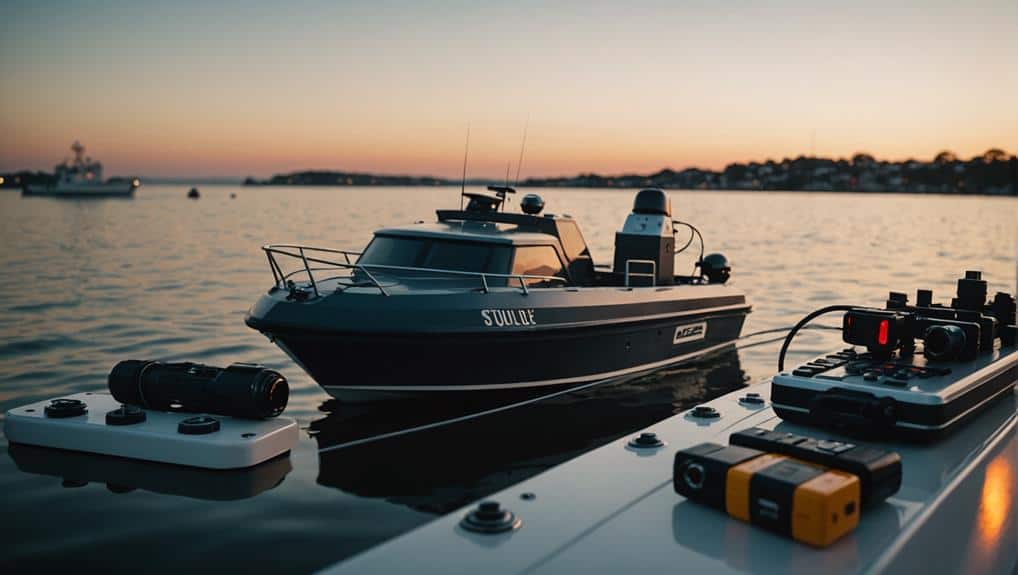When you’re out on the open water, beyond the safety of familiar shores, equipping yourself with innovative
self-defense tools can make all the difference in ensuring your security. Think of
compact stun guns like the Slider Pink, perfect for confined spaces, or the
MACE Pepper Gun 2.0, which safely neutralizes threats with pepper spray bursts. For lighting up trouble, the Shorty flashlight stun gun disorients attackers with a dazzling 1,000 lumens. And let’s not forget
perimeter security systems like Siren Marine MTC, sending
real-time alerts straight to your smartphone. With these tools, you’ll be more than ready to face any watery threats that come your way. Keep going, and you’ll find even more ways to stay safe out there.
Understanding Boating Vulnerabilities
When you’re on a
long-distance cruise, the
open waters can present
unique weaknesses, especially when you’re far from familiar shores.
Robbery and other threats can become real concerns, particularly in
isolated international waters where help is scarce. You might rely on local communities for support, but this can sometimes amplify your weaknesses, making you a target for thieves or intruders.
Picture this: you’re anchored in a beautiful, remote cove, enjoying your morning coffee, when suddenly,
unwelcome guests board your boat. Scary, right? Theft, boarding by intruders, and even assaults aren’t just horror stories—they’re real incidents that boaters face. That’s why understanding and preparing for these weaknesses is crucial.
Self-defense isn’t just about having the right tools; it’s about regularly evaluating their effectiveness. Imagine feeling that knot of vulnerability tighten in your stomach, knowing you’re miles away from help.
Staying informed about local threats and engaging with the boating community can greatly enhance your safety. So, arm yourself not just with the latest gadgets, but with knowledge too. Remember, a
well-prepared boater is a safer, happier one.
Non-Lethal Defense Options
Understanding these vulnerabilities highlights the importance of equipping yourself with effective
self-defense tools. When you’re out on the water, your
inflatable life jacket isn’t the only gear you need.
Non-lethal defense options like the
Bouncer Stun Gun with Flashlight can be a game-changer. Sure, it looks like a regular flashlight, but it also stuns to deter intruders without causing permanent harm.
Imagine you’re facing potential threats like
armed pirates. The
MACE Brand Pepper Gun 2.0 steps in, delivering a pepper spray burst that incapacitates attackers. It’s perfect for handling multiple foes without resorting to lethal force.
Compact stun guns such as the Slider Pink Stun Gun can also be invaluable for
personal protection in tight spaces.
Non-lethal weapons (NWLs) such as stun guns and pepper sprays are preferred because they reduce the risk of fatal encounters and legal complications. After all, you don’t want to end up in court just because you tried to protect yourself. On a boat, where space is tight and property damage is a concern, NWLs shine. They’re effective without escalating violence or damaging your vessel.
Legal regulations can vary, so always check your local laws before acquiring any NWLs. You wouldn’t want to get in trouble for trying to stay safe in the first place, right
Recommended Self-Defense Devices
Equipping your boat with the right self-defense devices can make a world of difference in guaranteeing your safety on the water. One essential piece of tactical gear is the Shorty stun flashlight. With its impressive 1,000 lumens and a reach of 656 feet, this compact flashlight not only illuminates dark areas but can also disorient potential attackers. It’s a budget-friendly yet powerful tool for your boat’s arsenal. Another useful device is a rechargeable
Fang Keychain Stun Gun, which is compact and easy to carry, assuring you have an effective self-defense tool at hand.
Don’t skimp on your boat’s safety. These devices, from flashlight features to tactical gear, guarantee you’re prepared for whatever comes your way.
Enhancing Perimeter Security
Enhancing
perimeter security on your boat is essential for peace of mind and safety. With
motion detection systems and
remote monitoring solutions, you can keep a close eye on your vessel even when you’re not around. Imagine having the Siren Marine MTC device on your boat. It connects to your smartphone and sends you
real-time alerts for any perimeter breaches, so you’re always in the loop.
But that’s not all. The Aqualarm system can dial your cell number and shoot out emails if it detects a
security breach. It’s like having a vigilant friend watching over your boat while you enjoy your day.
Environmental sensors add another layer of protection by detecting changes like unauthorized access, ensuring you’re always one step ahead of potential threats.
Canvas snap sensors are another nifty tool. They alert you when someone unsnaps your boat cover, giving you a heads-up about any unwanted visitors. Regularly evaluating and placing
tactical tools, such as flashlights and alarms, in easy-to-reach spots can make all the difference during
emergencies. So, gear up and make sure your boat’s perimeter is as secure as Fort Knox!
Training and Preparation
Being prepared for self-defense on a boat isn’t just about having the right tools; it’s about knowing how to use them effectively. Imagine you’re out at sea, enjoying a calm day, and suddenly, an emergency scenario unfolds. Without proper training in self-defense drills, having a tactical flashlight or pepper spray won’t be enough. You need to know how to access and use these tools swiftly and confidently.
Regularly practicing self-defense drills can be a game-changer. Not only do they enhance your skills, but they also boost your confidence, making you more prepared to handle any situation. Engage in emergency scenarios to improve your response time and situational awareness. This way, you can recognize potential dangers before they escalate.
| Training Activity |
Purpose |
| Self-defense drills |
Improve response skills |
| Accessing tools quickly |
Guarantee readiness |
| Situational awareness |
Recognize and prevent threats |
Don’t forget to familiarize yourself with local laws regarding self-defense tools. Knowing what’s legal can save you from potential legal headaches. Remember, preparation isn’t just about gear; it’s about practice, confidence building, and being ready for anything. So, keep training, stay alert, and sail safely!
Frequently Asked Questions
How Can I Maintain Self-Defense Tools to Ensure Long-Term Reliability?
You can guarantee your self-defense tools stay reliable by using proper tool storage solutions, following regular maintenance schedules, and applying corrosion prevention techniques. Keep them dry, inspect them frequently, and use protective coatings to prevent rust.
Are There Specific Regulations for Carrying Self-Defense Tools on Boats?
You need to understand boat safety regulations and self-defense laws before carrying any tools on your vessel. Maritime security guidelines vary, so check local and federal rules to guarantee you’re compliant and prepared for any situation.
What Are the Signs That Indicate a Potential Threat While Boating?
Think of potential threats like storm clouds on the horizon. Watch for suspicious behavior, hear unusual sounds, or spot unexpected vessels. Trust your instincts and stay alert to guarantee you don’t get caught off guard.
How Can I Discreetly Carry Self-Defense Tools on a Small Boat?
You can use concealed storage compartments for your self-defense tools. Choose lightweight options like pepper spray or a small stun gun. Make certain they’re easily accessible in an emergency, but discreet enough not to raise suspicion.
What Are the Best Practices for Using Self-Defense Tools in Different Weather Conditions?
When the weather’s as unpredictable as a wild card, you need weather adaptability strategies. Regularly assess your tool’s effectiveness and consider environmental impact. Practice using tools in various conditions to guarantee you’re prepared for anything.







